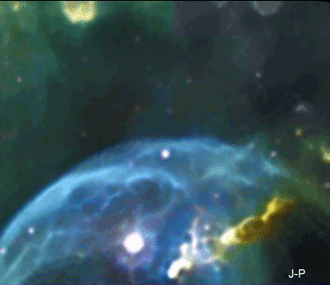COPYRIGHT, PLEASE NOTE
All the material on this website is copyrighted to J-P Metsavainio, if not otherwise stated. Any content on this website may not be reproduced without the author’s permission.
Have a visit in my portfolio
PORTFOLIO:https://astroanarchy.zenfolio.com/
Monday, September 5, 2011
Bubble Nebula reprocessed, again
Since my processing technique gets better and weather doesn't give any support, I have reprocessed some older images. There is now star colors added and other processing is tweaked too.
Sharpless 162, NGC 7635, the "Bubble Nebula"
Ra 23h 20m 48s Dec +61° 12′ 06″
A closeup
A closer closeup of the bubble feature
Not a bad resolution for an olde Meade LX200 GPS 12" telescope...
I made this animation originally to be sure, that I don't have any artifacts from my experimental processing workflow.

I made this animation originally to be sure, that I don't have any artifacts from my experimental processing workflow.

This is one of the most interesting looking structures in a sky.
NGC 7635 aka "Bubble Nebula, Sh2-162 or Caldwell11, is a Hydrogen emission nebula in constellation Cassiopeia. It locates near the open cluster M 52 at distance of about 11.000 light years from the Earth.
The bubble structure is created by a strong stellar wind, a radiation pressure, from massive hot magnitude 8,7 central star, SAO 20575, it can be seen in an image inside of the bubble, off centered at Right.
NGC 7635 aka "Bubble Nebula, Sh2-162 or Caldwell11, is a Hydrogen emission nebula in constellation Cassiopeia. It locates near the open cluster M 52 at distance of about 11.000 light years from the Earth.
The bubble structure is created by a strong stellar wind, a radiation pressure, from massive hot magnitude 8,7 central star, SAO 20575, it can be seen in an image inside of the bubble, off centered at Right.
Bubble is an expanding shock front inside a giant molecular cloud and it has a diameter more than Six light years. The spherical formation is expanding at speed of 6500.000 km/h, due the huge scale and distance we can't see the movement easily. In a century, the bubble in this image will be only about one pixel wider, than now! ( ~1 arc second)
Strong UV-radiation from a central star ionized elements in a gas and makes them glow at typical wavelength to each element. (Hydrogen glows Red light as Sulfur, Oxygen emits Green/Blue light at visible wavelengths)
If you are interested about color schemes used in my images, I wrote a small study about them, please, have a look here: http://astroanarchy.blogspot.com/2009/11/colors-in-astro-images.html
Natural color composition from the emission of ionized elements, R=80%Hydrogen+20%Sulfur, G=100%Oxygen and B=85%Oxygen+15%Hydrogen to compensate otherwise missing H-beta emission. Star colors are mixed from the NB channels, Red=H-a, G=O-III and B= 85%O-III + 15%H-a.This composition is very close to a visual spectrum.
A closeup
Previous version of the Bubble Nebula can be seen here:
Please, let me know, if this one looks better!
Processing work flow:
Image acquisition, MaxiDL v5.07.
Stacked and calibrated in CCDStack.
Deconvolution with a CCDSharp, 30 iterations.
Levels, curves and color combine in PS CS3.
-
Imaged in three nights between 27.09 - 04-09 2009, seeing varys between 4-2,5 FWHM
Telescope, Meade LX200 GPS 12" @ f4.65 Camera, QHY9 Guiding, SXV-AO @ 11Hz
Exposures:
H-alpha 21x1200s Binned 1x1 = 7h
S-II 10x600s Binned 3x3
O-III 5x600s Binned 3x3
A study of the apparent scale in a sky
NOTE. The size of the full Moon (0,5 degrees) is marked as a scale.
3D-study of the Bubble Nebula:
http://astroanarchy.blogspot.com/2009/10/bubble-nbula-as-stereogram.html
3D-study of the Bubble Nebula:
http://astroanarchy.blogspot.com/2009/10/bubble-nbula-as-stereogram.html
Wide field images of the Bubble Nebula area
Sharpless 157, Sh2-157, in a middle, Bubble Nebula can be seen at about ten a clock position.
A panoramic, two panel mosaic, from the Bubble to the Wizard Nebula at Right.
Subscribe to:
Post Comments (Atom)

















No comments:
Post a Comment